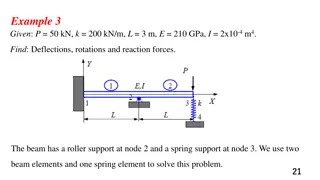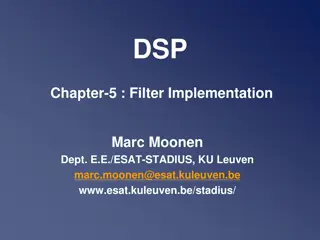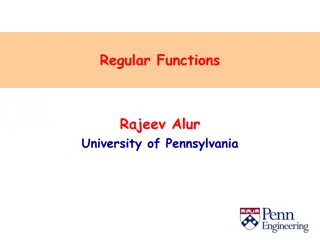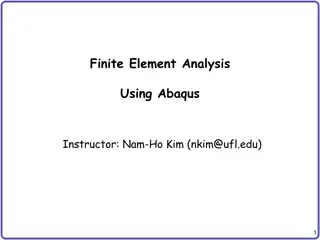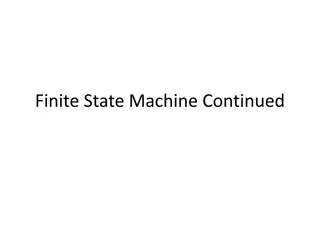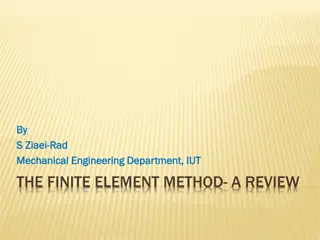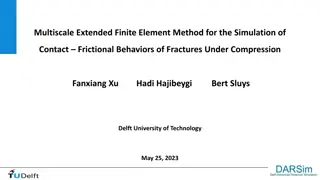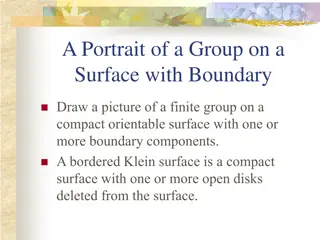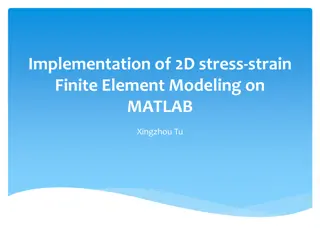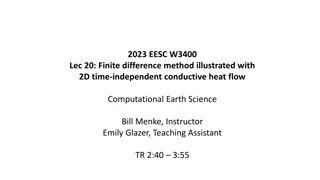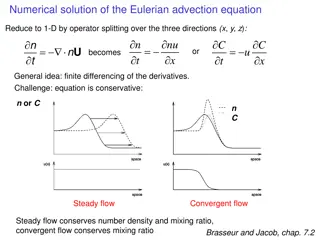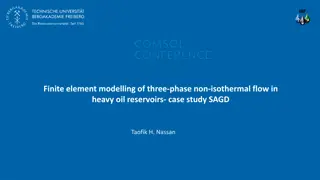Engineering Beam Analysis using Finite Element Method
Solve beam analysis problems involving deflections, rotations, and reaction forces using the finite element method. The examples provided cover scenarios with roller supports, spring supports, and internal hinges. Learn how to determine displacements, rotations, and element forces in beams of varyin
6 views • 42 slides
Enhancing Finite Element Analysis with Overlapping Finite Elements in Julia
Finite Element Methods (FEM) play a crucial role in solving complex PDEs in various domains. Overlapping Finite Elements in Julia aim to minimize reliance on mesh quality, improving solution accuracy. By leveraging Julia's matrix capabilities and efficient implementations, users can achieve faster c
1 views • 19 slides
Chapter 5: Filter Implementation and Finite Word-Length Problem Overview
This chapter delves into the implementation challenges of digital filters, particularly focusing on the finite word-length problem. It discusses issues such as coefficient quantization, arithmetic operations, quantization noise, statistical analysis, limit cycles, and scaling. Various realizations a
5 views • 32 slides
Finite Automata and Regular Functions in Computer Science
Exploring the concepts of regular functions, languages vs functions, finite-state computation, finite automata with cost labels, finite automata with cost registers, and examples of Cost Register Automata. These topics delve into the theoretical and practical aspects of defining functions and comput
4 views • 46 slides
Finite and Non-finite Verbs in English Grammar
Explore the concept of finite and non-finite verbs through examples and explanations. Learn to identify different types of verbs, their relationship with subjects and tenses, and how they function in sentences. Enhance your understanding of English grammar with practical insights and tips provided i
6 views • 19 slides
Finite Element Analysis Using Abaqus: Basics and Methods
Learn about the basics and methods of Finite Element Analysis using Abaqus. Explore topics such as preprocessing, interactive mode, analysis input files, components modeling, FEM modeling, and more. Understand the advantages and disadvantages of using GUI versus Python scripting, and how to create F
5 views • 33 slides
Finite and Non-Finite Verbs in English Grammar
This content introduces the concept of finite and non-finite verbs in English grammar through examples and explanations. It covers the definitions, identification, and usage of finite and non-finite verbs, with practical examples provided for better understanding. The tips mentioned help in distingu
5 views • 20 slides
Finite State Machines in Digital Logic Design
Finite state machines play a crucial role in digital logic systems, allowing for the implementation of sequential circuit designs. These machines consist of states and transition functions, determining system behavior based on inputs and current state. The output function generates outputs based on
1 views • 35 slides
Update on Alameda County Community Development Agency Planning Projects
Alameda County Community Development Agency Planning Department's update on general plan projects focusing on the Housing Element, Environmental Justice Element, and Safety Element. The General Plan is required by State Law, with specific elements such as Land Use, Circulation, Open Space, Conservat
1 views • 25 slides
An Overview of Finite Element Method in Mechanical Engineering
Finite Element Method (FEM) in mechanical engineering is a powerful numerical technique involving dividing a domain into finite elements, establishing relations between variables, and assembling elements to analyze a system. This method is fundamental for solving one-dimensional problems and approxi
5 views • 63 slides
Neutron Star Mergers and Ultra Heavy Element Cosmic Rays: Exploring Their Connection
Delve into the intriguing link between neutron star mergers and the synthesis of ultra heavy element cosmic rays. The rapid neutron capture process, known as r-process, plays a crucial role in creating elements heavier than iron through events like neutron star mergers and core-collapse supernovae.
1 views • 19 slides
Computational Earth Science: Solving Heat Flow in Objects with Complex Shapes Using Finite Difference Method
Explore projects involving the Finite Difference Method for solving static heat conduction problems, also known as the Poisson Equation. Topics include testing boundary conditions, symmetry of solutions, point sources, dipoles, and more. Gain insights into changing boundary conditions and understand
2 views • 20 slides
Multiscale Extended Finite Element Method for Fracture Contact Simulation
Simulation of contact frictional behaviors of fractures under compression using the Multiscale Extended Finite Element Method (XFEM). The method involves solving governing equations, incorporating additional degrees of freedom, and employing penalty methods. MS-XFEM enhances computational efficiency
4 views • 13 slides
Navigating Challenges in the AI Industry: Element AI Analysis and Recommendations
In this presentation, the team explores the growth trajectory of Element AI amidst hurdles in the industry. They discuss key issues, objectives, and provide a recommendation for Element AI to establish a North American AI conglomerate. The analysis delves into the AI industry overview, challenges of
3 views • 40 slides
Finite Groups on Compact Surfaces with Boundaries
Illustrating the concept of finite group structures on compact surfaces with boundaries, this presentation showcases transformations, orientations, and color-coding used to represent group elements. By identifying regions in the hyperbolic plane and applying inversions, the images provide insights i
5 views • 28 slides
The Housing Element Update in West Hollywood
Explore the Housing Element Update in West Hollywood, covering topics like the planning process, regional housing needs assessment, current housing trends, and future steps. Learn about the significance of the Housing Element, its requirements under state law, and the key aspects of the 2013-2021 pl
1 views • 36 slides
Finite Element Modeling for Stress-Strain Analysis in 2D Structures
Explore the implementation of 2D stress-strain Finite Element Modeling using MATLAB. Understand the concepts of stress, strain, plane stress conditions, stress-strain relation, Turner Triangle in FEM, linear interpolation, stress and strain vectors, static equilibrium, and stiffness matrix. Learn ho
2 views • 18 slides
Finite Element Analysis of the Third Generation Mirror Suspension System for Voyager
Michelson Interferometer at LIGO measures strain in space-time for gravitational waves. Learn about thermal noise sources, Finite Element Analysis, and thermal energy storage in the mirror suspension system.
1 views • 13 slides
GFDL Finite Volume Cubed-sphere Dynamical Core (FV3)
Finite-volume approach resulting in the GFDL Finite Volume Cubed-sphere Dynamical Core (FV3) with features like grid stretching, horizontal discretization, and Lagrangian vertical coordinate for hydrostatic atmosphere equations on a sphere.
3 views • 10 slides
Finite Difference Method for Conductive Heat Flow in Solids
Illustrated with examples, the finite difference method is applied to analyze 2D time-independent conductive heat flow in solids. The conservation of heat energy, temperature variation in heat-conducting solids, and boundary conditions are discussed in detail. Emphasis is placed on solution techniqu
3 views • 65 slides
Numerical Solution of Eulerian Advection Equation in 1-D Operator Splitting
The Eulerian advection equation is solved numerically in 1-D by operator splitting over the x, y, and z directions. The process involves finite differencing of derivatives and ensuring conservation in steady and convergent flows. Different finite-difference approximations of derivatives are discusse
2 views • 13 slides
Introduction to Finite Automata and Recognizers
Finite Automata (FA) are graphical models used to compile regular expressions into recognizers capable of determining if a given string is part of a specific language. Non-deterministic Finite Automata (NFA) allow for multiple transitions from a state on the same input symbol, while Deterministic Fi
3 views • 8 slides
Finite Element Modelling of Three-Phase Non-Isothermal Flow in Heavy Oil Reservoirs
Explore the case study on SAGD (Steam-Assisted Gravity Drainage) focusing on the finite element modelling of three-phase non-isothermal flow in heavy oil reservoirs. Discover the impact of temperature on viscosity and the configuration of SAGD operations. Dive into the mathematical model behind the
5 views • 15 slides
Finite Automata: Types, Definitions, and Examples
Learn about Deterministic Finite Automata (DFA) and Nondeterministic Finite Automata (NFA), their definitions, differences, and examples. Understand the key concepts of finite automata, including states, input symbols, initial state, final states, and transition functions.
24 views • 59 slides
Compiler Design Overview and Phases
Learn about the introduction to compilers, their functions, compiler phases, finite state machines, deterministic finite automata (DFA), and non-deterministic finite automata (NDFA), essential concepts in compiler design.
1 views • 8 slides
Finite State Morphology Overview
Finite State Morphology is a detailed study of word formation processes, including inflection, derivation, and compounding. It covers concepts like word forms, roots, affixes, and morphemes with examples from computational morphology. This study explores how regular expressions are converted into fi
3 views • 19 slides
Finite State Algorithms in Computer Science
Explore the concept of finite state algorithms in computer science, covering topics such as deterministic finite automata and regular expressions. Learn about computing finite functions using circuits and the importance of generalization in algorithms.
1 views • 30 slides
Regular Expressions and Finite Automata Overview
Explore the relationship between regular expressions and finite automata in the context of lexical analysis, compiler design, and token specification. Learn about the implementation of lexical analyzers as finite state machines and the synthesis of FSMs to recognize desired patterns. Discover how tr
0 views • 14 slides
Side Impact Beams for Car Safety
Dive into the world of side impact beams, exploring their types, material properties, finite element analysis, energy absorption, and more. Learn about different safety measures, such as airbags, steel, aluminum beams, and fiberglass beams. Discover the differences between aluminum and steel in term
4 views • 12 slides
Introduction to Finite Element Method for Structural Analysis
This course covers the fundamental concepts of the Finite Element Method (FEM) for solving structural engineering problems. You will explore topics such as FEA theory, ANSYS software, trusses, beams, plates, and more. The course emphasizes practical application through homework assignments, quizzes,
3 views • 34 slides
Finite Element Modelling of Three-Phase Non-Isothermal Flow in Heavy Oil Reservoirs - SAGD Case Study
Explore the finite element modelling of three-phase non-isothermal flow in heavy oil reservoirs through a detailed case study on SAGD, including an introduction to TEOR techniques, temperature effects on viscosity, API classification of crude oil, and mathematical models for continuity and momentum
2 views • 15 slides
Finite State Morphology SFST Programming Concepts
Explore the basics of SFST programming language for developing finite-state transducers, learn how to work with SFST, write code in terminal, and analyze example sessions and exercises. Enhance your understanding of finite-state morphology through practical examples and exercises.
0 views • 26 slides
H-Method and P-Method in Finite Element Modeling
Learn about the significance of convergence in finite element analysis, the differences between h-method and p-method, and how these methods enhance accuracy by adjusting mesh size and polynomial degree, respectively, to obtain reliable solutions. Discover the iterative process to achieve convergenc
2 views • 10 slides
Finite Element Programming with MATLAB Lecture-13 MATLAB Codes
Learn about finite element analysis using MATLAB codes for spring elements in a structural problem. Understand the steps, boundary conditions, system stiffness matrix computation, and solution implementation. Explore the MATLAB code snippets provided for structure, displacements, forces, stiffness,
3 views • 11 slides
Cryptology Mathematical Background: Groups, Rings, Finite Fields Overview
Explore the mathematical concepts of groups, rings, and finite fields in cryptology. Learn about the Euler function, multiplicative orders, and element orders in the ring of integers modulo m. Solve problems related to invertible elements, multiplicative orders, and element orders in Z33.
0 views • 7 slides
Finite Element Modeling of Three-Phase Non-Isothermal Flow in Heavy Oil Reservoirs - SAGD Case Study
Explore the finite element modeling of three-phase non-isothermal flow in heavy oil reservoirs through a detailed case study on Steam-Assisted Gravity Drainage (SAGD). Discover the significance of temperature effects on viscosity and the classification of crude oil based on API viscosity. Gain insig
0 views • 15 slides
Finite Element Discretization for Structural Domain Equations
Explore figures depicting numerical solutions, exact solutions, and finite element discretizations for structural domain equations. Understand concepts such as approximate solutions, interpolated solutions, and gradients, with comparisons between exact and approximate values.
0 views • 10 slides
Introduction to Finite State Machines in Engineering Design
Explore the concept of finite state machines in engineering design, with examples such as a dancing robot and a robot following a magnetic strip. Learn how state transitions control actions using sensors and without sensors in various scenarios. Discover how finite state machines model real-life pro
0 views • 18 slides
Understanding Button Debouncing and Finite State Machines in FPGA Development
Explore the concepts of buttons, debouncing, and finite state machines in FPGA development using the Nexys3 board. Learn how to mitigate switch bouncing, synchronize with clocks, and design digital debouncers for optimal performance. Gain insights into the functionality of a finite state machine for
2 views • 10 slides
Numerical Methods in Computational Fluid Dynamics and Discretization Techniques
Explore the essential concepts of numerical methods in computational fluid dynamics, including discretization methods, finite difference, finite volume, and finite elements. Learn how to transform differential equations into algebraic form and choose the right approach for accurate solutions in flui
2 views • 22 slides
